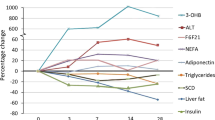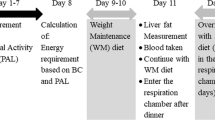Abstract
Background:
Several studies have reported increased fat oxidation with diacylglycerol (DAG) oil consumption. However, the effects of long-term DAG oil consumption on energy metabolism remain to be investigated.
Objective:
The objective of this study was to compare the effects of 14 days of either DAG or triacylglycerol (TAG) oil consumption on substrate oxidation, energy expenditure (EE) and dietary fat oxidation.
Design:
Eight males and six females participated in this randomized, double-blind, crossover feeding study. Each patient consumed the 14-day controlled test diet containing either 10 g day−1 of DAG or TAG oil for acclimatization before a respiratory chamber measurement, followed by a 2-week washout period between diet treatments. Substrate oxidation and EE were measured in the respiratory chamber at the end of each dietary treatment. The patients consumed test oil as 15% of total caloric intake in the respiratory chamber (mean test oil intake was 36.1±6.6 g day−1).
Results:
Twenty-four hour fat oxidation was significantly greater with 14 days of DAG oil consumption compared with TAG oil consumption (78.6±19.6 and 72.6±14.9 g day−1, respectively, P<0.05). There were no differences in body weight or body composition between diet treatments. Dietary fat oxidation was determined using the recovery rate of 13CO2 in breath, and was significantly enhanced with DAG oil consumption compared with TAG oil consumption, measured over 22 h after ingestion of 13C-labelled triolein. Resting metabolic rate (RMR) was significantly greater with DAG oil consumption compared with TAG oil consumption (1766±337 and 1680±316 kcal day−1, respectively, P<0.05).
Conclusion:
Consumption of DAG oil for 14 days stimulates both fat oxidation and RMR compared with TAG oil consumption, which may explain the greater loss of body weight and body fat with DAG oil consumption that has been observed in weight-loss studies.
This is a preview of subscription content, access via your institution
Access options
Subscribe to this journal
Receive 12 print issues and online access
$259.00 per year
only $21.58 per issue
Buy this article
- Purchase on Springer Link
- Instant access to full article PDF
Prices may be subject to local taxes which are calculated during checkout

Similar content being viewed by others
References
Ford ES, Giles WH, Dietz WH . Prevalence of the metabolic syndrome among US adults: findings from the third National Health and Nutrition Examination Survey. JAMA 2002; 287: 356–359.
Krauss RM, Winston M, Fletcher BJ, Grundy SM . Obesity: impact on cardiovascular disease. Circulation 1998; 98: 1472–1476.
Prentice AM, Poppitt SD . Importance of energy density and macronutrients in the regulation of energy intake. Int J Obes Relat Metab Disord 1996; 20: S18–S23.
Bray GA, Popkin BM . Dietary fat intake does affect obesity!. Am J Clin Nutr 1998; 68: 1157–1173.
Flatt JP, Ravussin E, Acheson KJ, Jéquier E . Effects of dietary fat on postprandial substrate oxidation and on carbohydrate and fat balances. J Clin Invest 1985; 76: 1019–1024.
Kien CL, Bunn JY, Ugrasbul F . Increasing dietary palmitic acid decreases fat oxidation and daily energy expenditure. Am J Clin Nutr 2005; 82: 320–326.
Dulloo AG, Fathi M, Mensi N, Girardier L . Twenty-four-hour energy expenditure and urinary catecholamines of humans consuming low-to-moderate amounts of medium-chain triglycerides: a dose–response study in a human respiratory chamber. Eur J Clin Nutr 1996; 50: 152–158.
Kamphuis MM, Mela DJ, Westerterp-Plantenga MS . Diacylglycerol affect substrate oxidation and appetite in humans. Am J Clin Nutr 2003; 77: 1133–1139.
D’ Alonzo RP, Kozarek WJ, Wade RL . Glyceride composition of processed fats and oils as determined by glass capillary gas chromatography. J Am Oil Chem Soc 1982; 59: 292–295.
Ogawa H, Okushima S, Kodama H . The cooking characteristics of diacylglycerol rich cooking oil when preparing dishes. J Integr Study Diet Habits 2001; 12: 100–108.
Rudkowska I, Roynette CE, Demonty I, Vanstone CA, Jew S, Jones PJ . Diacylglycerol: efficacy and mechanism of action of an anti-obesity agent. Obes Res 2005; 13: 1864–1876.
Nagao T, Watanabe H, Goto N, Onizawa K, Taguchi H, Matsuo N et al. Dietary diacylglycerol suppresses accumulation of body fat compared to triacylglycerol in men in a double-blind controlled trial. J Nutr 2000; 130: 792–797.
Maki KC, Davidson MH, Tsushima R, Matsuo N, Tokimitsu I, Umporowicz DM et al. Consumption of diacylglycerol oil as part of a reduced-energy diet enhances loss of body weight and fat in comparison with consumption of a triacylglycerol control oil. Am J Clin Nutr 2002; 76: 1230–1236.
Murata M, Ide T, Hara K . Reciprocal responses to dietary diacylglycerol of hepatic enzymes of fatty acid synthesis and oxidation in the rat. Br J Nutr 1997; 77: 107–121.
Murase T, Aoki M, Wakisaka T, Hase T, Tokimitsu I . Anti-obesity effect of dietary diacylglycerol in C57BL/6J mice: dietary diacylglycerol stimulates intestinal lipid metabolism. J Lipid Res 2002; 43: 1312–1319.
Murase T, Mizuno T, Omachi T, Onizawa K, Komine Y, Kondo H et al. Dietary diacylglycerol suppresses high fat and high sucrose diet-induced body fat accumulation in C57BL/6J mice. J Lipid Res 2001; 42: 372–378.
Saito S, Tomonobu K, Hase T, Tokimitsu I . Effects of diacylglycerol on postprandial energy expenditure and respiratory quotient in healthy subjects. Nutrition 2005; 22: 30–35.
Hibi M, Takase H, Yasunaga K, Yamaguchi T, Harada U, Katsuragi Y et al. Fat utilization in healthy subjects consuming diacylglycerol oil diet: dietary and whole body fat oxidation. Lipids 2008; 43: 517–524.
Watanabe T, Shimizu M, Sugiura M, Sato J, Kohori N, Yamada N et al. Optimization of reaction conditions for the production of DAG using immobilized 1,3-regiospecific lipase lipozyme RM IM. J Am Oil Chem Soc 2003; 80: 1201–1207.
Harris JA, Benedict FG . A Biometric Study of Basal Metabolism in Man. Carngie Institution: Washington DC, 1919.
Brown D, Cole TJ, Dauncey MJ, Marrs RW, Murgatroyd PR . Analysis of gaseous exchange in open-circuit in-direct calorimetry. Med Biol Eng Comput 1984; 22: 333–338.
Weir JB . New methods for calculating metabolic rate with special reference to protein metabolism. Nutrition 1949; 6: 213–221.
Brouwer E . On simple formulae for calculating the heat expenditure and the quantities of carbohydrate and fat oxidized in metabolism of men and animals, from gaseous exchange (oxygen intake and carbonic acid output) and urine-N. Acta Physiol Pharmacol Neerl 1957; 6: 795–802.
Schrauwen P, van Marken Lichtenbelt WD, Westerterp KR . Energy balance in a respiration chamber: individual adjustment of energy intake to energy expenditure. Int J Obes Relat Metab Disord 1997; 21: 769–774.
Tataranni PA, Larson DE, Snitker S, Ravussin E . Thermic effect of food in humans: methods and results from use of a respiratory chamber. Am J Clin Nutr 1995; 61: 1013–1019.
Jéquier E, Schutz Y . Long-term measurements of energy expenditure in humans using a respiration chamber. Am J Clin Nutr 1983; 37: 603–611.
St-Onge MP, Jones PJ . Physiological effects of medium-chain triglycerides: potential agents in the prevention of obesity. J Nutr 2002; 132: 329–332.
St-Onge MP, Bourque C, Jones PJ, Ross R, Parsons WE . Medium- versus long-chain triglycerides for 27 days increases fat oxidation and energy expenditure without resulting in changes in body composition in overweight women. Int J Obes Relat Metab Disord 2003; 27: 95–102.
St-Onge MP, Ross R, Parsons WD, Jones PJ . Medium-chain triglycerides increase energy expenditure and decrease adiposity in overweight men. Obes Res 2003; 11: 395–402.
St-Onge MP, Bosarge A . Weight-loss diet that includes consumption of medium-chain triacylglycerol oil leads to a greater rate of weight and fat mass loss than does olive oil. Am J Clin Nutr 2008; 87: 621–626.
Sonko BJ, Fennessey PV, Donnelly JE, Bessesen D, Sharp TA, Jacobsen DJ et al. Ingested fat oxidation contributes 8% of 24-h total energy expenditure in moderately obese subjects. J Nutr 2005; 135: 2159–2165.
Schutz Y, Tremblay A, Weinsier RL, Nelson KM . Role of fat oxidation in the long-term stabilization of body weight in obese women. Am J Clin Nutr 1992; 55: 670–674.
Ravussin E, Burnand B, Schutz Y, Jéquier E . Twenty-four-hour energy expenditure and resting metabolic rate in obese, moderately obese, and control subjects. Am J Clin Nutr 1982; 35: 566–573.
Acknowledgements
This study was supported by Kao Corporation. We thank Hironobu Miyauchi of Fuji Medical Science Co., Ltd. for assistance with the measurement of energy metabolism in the respiratory chamber, and Dr Akiyoshi Uchiyama of Artage Inc. for advice on the statistical analysis.
Author information
Authors and Affiliations
Corresponding author
Rights and permissions
About this article
Cite this article
Hibi, M., Takase, H., Yasunaga, K. et al. Greater fat oxidation with diacylglycerol oil consumption for 14 days compared with triacylglycerol oil consumption in overweight men and women. Int J Obes 32, 1841–1847 (2008). https://doi.org/10.1038/ijo.2008.197
Received:
Revised:
Accepted:
Published:
Issue Date:
DOI: https://doi.org/10.1038/ijo.2008.197



